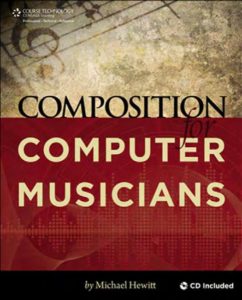Table of Contents
Come join us now, and enjoy playing your beloved music and browse through great scores of every level and styles!
Can’t find the songbook you’re looking for? Please, email us at: sheetmusiclibrarypdf@gmail.com We’d like to help you!
Composition For Computer Musicians (eBook) by Michael Hewitt.
Please, subscribe to our Library.
If you are already a subscriber, please, check our NEW SCORES’ page every month for new sheet music. THANK YOU!

Best Sheet Music download from our Library.
You might be extremely knowledgeable about the software that you use, have a good understanding of your own genre, and even have a good basic understanding of music theory. However, this does not necessarily mean that you can write effective music tracks. You need another kind of knowledge as well – the knowledge of composition.
This friendly guide explains the basics of composing songs and music on the computer using any music creation and recording program. Whether you choose Reason, Live, Cubase, Logic, Pro Tools, Digital Performer, Finale, Sibelius, FL Studio, SONAR, or anything else.
It’s not as hard as it sounds, and this book eases the learning curve so you’ll be making music in no time. You’ll quickly learn how to program rhythm and drums, create bass lines and melodic leads, and use FX and samples. You’ll also learn about mixing and mastering your track and distributing it to a mass audience. Composition for Computer Musicians explains it all while showing you the basics of music theory throughout, so you’ll be sure you’re not just making noise on the computer – you’re using your computer to make professional-sounding music.
Chapters:
Introduction. 1: Getting the Most from your Setup. 2: Know Your Genre. 3: Rhythm and Drum Programming. 4: Bass Lines. 5: Writing Melodic Leads. 6: Creative Use of FX. 7: Writing for Strings and Pads. 8: Writing for Acoustic Instruments. 9: Writing Effective Riffs. 10: Arpeggiation as a Creative Tool. 11: Creative use of Sampling. 12: Creative use of Control Data. 13: Approaching Structure. 14: Layering Your Music. 15: Sequencing Your Music. 16: Percussion in Different Contexts. 17: Get the Atmosphere Right. 18: Mixing – Creative Use of Volume, Panning and EQ. 19: Mastering Your Track. 20: Getting Your Tracks Heard. 21: Developing a Portfolio. 22: Conclusion.
About the author, Michael Hewitt:
Dr. Michael Hewitt was born in South Wales in the United Kingdom. He earned his bachelor of music degree at London University and a master’s degree and doctorate at the University of Bangor, where he specialized in musical composition. He is a classically trained musician, a composer, a lecturer, and an author on musical subjects. Working to commission, he writes classical scores as well as soundtracks for various television productions, both at home and abroad. He is currently working as a music technology tutor at Coleg Harlech, North Wales.
Browse in the Library:
Or browse in the categories menus & download the Library Catalog PDF:
About this book
Composition as a subject concerns itself with the answers to such questions as: How do I write a good drum track? What is the best way to write a bassline? How do I write a beautiful, soaring melodic lead? How do I write a percussion track? What is the best way to structure my music? The answers to these types of questions all fall under the cover of the blanket term composition, and whatever kind of music you write, you will be using composition and compositional techniques at every stage.
A compositional technique is a procedure that you follow to obtain an effective musical result. Knowledge of these techniques is essential for the process of good music writing.
Imagine a bricklayer going to build a brick wall without knowledge of the techniques of bricklaying. There are only so many ways to build a sturdy wall effectively with bricks. Without knowledge of what these are, though, the whole process of building a wall would be very random and haphazard, and you probably would not want to pay good money to have a wall such as this built for you. It is exactly the same with music.
There are tried-and-true techniques and methods for writing and building up musical material, and these are just as essential for a music producer or composer to know about as the techniques of wall building are for a bricklayer to know.
A person writing his or her own music tracks won’t get very far without a clear understanding of musical structure. There are specific ways to organize and structure your musical material that, over a long period of time, have proven themselves to be universally effective.
These ways are a type of compositional technique, a method for the organization and
arrangement of your musical material. Learning about these different methods as they apply to the different parameters of the music that you are writing is, in effect, learning about the process of musical composition.
